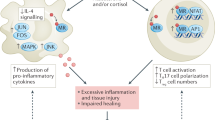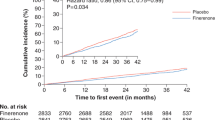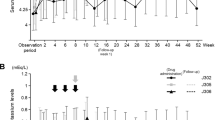Abstract
Diabetes mellitus is the main cause of chronic kidney disease (CKD) in Japan and worldwide. Although angiotensin-converting enzyme (ACE) inhibitors and angiotensin II type 1 receptor blockers (ARBs) are basic drugs for the treatment of CKD with diabetes (diabetic kidney disease, DKD) with albuminuria and/or proteinuria, it has also become clear that the use of an ACE inhibitor or ARB alone is not fully sufficient. We have previously reported the clinical effects of mineralocorticoid receptor (MR) antagonists and recommended their use in addition to renin–angiotensin system inhibitors. Recently, new types of nonsteroidal MR antagonists have been developed, and the results of a large-scale study are expected. Nonsteroidal MR antagonists are distributed in the heart, lungs, liver, and kidneys when administered orally and are characterized by their equivalent distribution between the heart (nonepithelial tissue) and kidneys (epithelial tissue). We summarize the latest evidence regarding the use of nonsteroidal MR antagonists in the treatment of DKD. Hyperkalemia and renal dysfunction are frequent during MR antagonist treatment. However, with careful and combined monitoring of these two conditions, the effectiveness of MR antagonists will not be diminished; conversely, it is apparent that patients at such risk will benefit more from the addition of an MR antagonist to the treatment regimen. The most important measure against hyperkalemia is the regular monitoring of serum potassium levels and renal function. The safest and most reliable measure against hyperkalemia is the combined use of a new oral potassium adsorbent that has high potassium selectivity and few side effects. In DKD treatment, it is important to continue using MR antagonists without interruption as much as possible.
This is a preview of subscription content, access via your institution
Access options
Subscribe to this journal
Receive 12 print issues and online access
$259.00 per year
only $21.58 per issue
Buy this article
- Purchase on Springer Link
- Instant access to full article PDF
Prices may be subject to local taxes which are calculated during checkout



Similar content being viewed by others
References
Murphy D, McCulloch CE, Lin F, Banerjee T, Bragg-Gresham JL, Eberhardt MS, for the Centers for Disease Control and Prevention Chronic Kidney Disease Surveillance Team, et al. Trends in prevalence of chronic kidney disease in the United States. Ann Intern Med. 2016;165:473–81.
Coresh J, Selvin E, Stevens LA, Manzi J, Kusek JW, Eggers P, et al. Prevalence of chronic kidney disease in the United States. JAMA. 2007;298:2038–47.
Thomas MC, Cooper ME, Zimmet P. Changing epidemiology of type 2 diabetes mellitus and associated chronic kidney disease. Nat Rev Nephrol. 2016;12:73–81.
Brenner BM, Cooper ME, de Zeeuw D, Keane WF, Mitch WE, Parving HH.RENAAL Study Investigators, et al. Effects of losartan on renal and cardiovascular outcomes in patients with type 2 diabetes and nephropathy. N Engl J Med. 2001;345:861–9.
Parving HH, Lehnert H, Bröchner-Mortensen J, Gomis R, Andersen S, Arner P.Irbesartan in Patients with Type 2 Diabetes and Microalbuminuria Study Group. The effect of irbesartan on the development of diabetic nephropathy in patients with type 2 diabetes. N Engl J Med. 2001;345:870–8.
ADVANCE Collaborative Group. Effects of a fixed combination of perindopril and indapamide on macrovascular and microvascular outcomes in patients with type 2 diabetes mellitus (the ADVANCE trial): a randomised controlled trial. Lancet 2007;370:829–40.
Sato A, Saruta T. Aldosterone escape during angiotensin-converting enzyme inhibitor therapy in essential hypertensive patients with left ventricular hypertrophy. J Int Med Res. 2001;29:13–21.
Sato A, Hayashi K, Naruse M, Saruta T. Effectiveness of aldosterone blockade in patients with diabetic nephropathy. Hypertension. 2003;41:64–68.
Sato A. The necessity and effectiveness of mineralocorticoid receptor antagonist in the treatment of diabetic nephropathy. Hypertens Res. 2015;38:367–74.
Albert NM, Yancy CW, Liang L, Zhao X, Hemandez AF, Peterson ED, et al. Use of aldosterone antagonists in heart failure. JAMA. 2009;302:1658–65.
Margolis J, Gerber RA, Roberts C, Gheorghiade M. Adherence to aldosterone-blocking agents in patients with heart failure. Am J Ther. 2010;17:446–54.
Ferreira JP, Rossignol P, Machu JL, Sharma A, Girerd N, Anker SD, et al. Mineralocortiocid receptor antagonist pattern of use in heart failure with reduced ejection fraction: findings from BIOSTAT-CHF. Eur J Heart Fail. 2017;19:1284–93.
Lastra G, Syed S, Romanyne Kurukulasuiya L, Manrique C, Sowers JR. Type 2 diabetes mellitus and hypertension: an update. Endocrinol Metab Clin North Am. 2014;43:103–22.
Ferrannini E, Cushman WC. Diabetes and hypertension;the bad companions. Lancet. 2012;380:601–10.
Feldstein CA. Salt intake, hypertension and diabetes mellitus. J Hum Hypertens. 2002;16:S48–51.
Wijkman M, Lanne T, Engvall J, Lindstrom T, Ostgren CJ, Nystrom FH. Masked nocturnal hypertension-a novel marker of risk in type 2 diabetes. Diabetologia. 2009;52:1258–264.
Unger T, Borghi C, Charchar F, Khan NA, Poulter NR, Prabhakaran D, et al. 2020 International society of hypertension global hypertension practice guidelines. Hypertension. 2020;75:1334–57.
Williams B, Mancia G, Spiering W, Agabiti Roser E, Axixi M, Burnier M.Authors/Task Force Members, et al. 2018 ESC/ESH Guidelines for the management of arterial hypertension. J Hypertens. 2018;36:1953–2041.
Umemura S, Arima H, Arima S, Asayama K, Dohi Y, Hirooka Y, et al. The Japanese Society of Hypertension Guidelines for the Management of Hypertension (JSH 2019). Hypertens Res. 2019;42:1235–481.
Buter H, Hemmelder MH, Navis G, de Jong PE, de Zeeuw D. The blunting of the antiproteinuric efficacy of ACE inhibition by high sodium intake can be restored by hydrochlorothiazide. Nephrol Dial Transpl. 1998;13:1682–5.
Saruta T, Kageyama S, Ogihara T, Hiwata K, Ogawa M, Tawara K, et al. Efficacy and safety of the selective aldosterone blocker eplerenone in Japanese patients with hypertension: a randomized, double-blind, placebo-control, dose-ranging study. J Clin Hypertens. 2004;6:175–83.
Sato A, Fukuda S. Clinical effects of eplerenone, a selective aldosterone blocker, in Japanese patients with essential hypertension. J Hum Hypertens. 2010;24:387–94.
Williams B, MacDonald TM, Morant S, Webb DJ, Sever P, McInnes G.for the British Hypertension Society’s PATHWAY Studies Group, et al. Spironolactone versus placebo, bisoprolol, and doxazosin to determine the optimal treatment for drug-resistant hypertension (PATHWAY-2): a randomized, double-blind, crossover trial. Lancet. 2015;386:2059–68.
Bomback AS. The incidence and implications of aldosterone breakthrough. Nat Clin Pr Nephrol. 2007;3:486–92.
Naruse M, Tanabe A, Sato A, Takage S, Tsuchiya K, Imaki T, et al. Aldosterone breakthrough during angiotensin II receptor antagonist therapy in stroke-prone spontaneously hypertensive rats. Hypertension. 2002;40:28–33.
Guo C, Martinez-Vasquez D, Mendez GP, Toniolo MF, Yao TM, Oestreicher EM, et al. Mineralocorticoid receptor antagonist reduces renal injury in rodent models oftypes 1 and 2 diabetes mellitus. Endocrinology. 2006;147:53635373.
Taira M, Toba H, Murakami M, Iga I, Serizawa R, Murata S, et al. Spironolactone exhibits direct renoprotective effects and inhibits renal renin-angiotensin-aldosterone system in diabetic rats. Eur J Pharm. 2008;589:264–71.
Sato A, Funder JW. High glucose stimulates aldosterone-induced hypertrophy via type I mineralocorticoid receptors in neonatal rat cardiomyocytes. Endocrinology. 1996;137:4145–53.
Hirohama D, Nishimoto M, Ayuzawa N, Kawarazaki W, Fujii W, Oba S, et al. Activation of Rac1-mineralocorticoid receptor pathway contributes to renal injury in salt-loaded db/db mice. Hypertension. 2021;78:82–93.
Nagase M, Yoshida S, Shibata S, Nagase T, Gotoda T, Ando K, et al. Enhanced aldosterone signaling in the early nephropathy of rats with metabolic syndrome: possible contribution of fat-derived factors. J Am Soc Nephrol. 2006;17:3438–46.
Shibata H, Itoh H. Mineralocorticoid receptor-associated hypertension and its organ damage: clinical relevance for resistant hypertension. Am J Hypertens. 2012;25:514–23.
Ido Y, Kilo C, Williamson JR. Cytosolic NADH/NAD+, free radicals, and vascular dysfunction in early diabetes mellitus. Diabetologia. 1997;40:S115–117.
Williamson JR, Chang K, Frangos M, Hasan KS, Ido Y, Kawamura T, et al. Hyperglycemic pseudohypoxia and diabetic complications. Diabetes. 1993;42:801–13.
Liu YJ, Nakagawa Y, Toya K, Wang Y, Saegusa H, Nakanishi T, et al. Effects of spironolactone on systolic blood pressure in experimental diabetic rats. Kidney Int. 2000;57:2064–71.
Pitt B, Zannad F, Remme W, Cody R, Castaigne A, Perez A, for The Randomized Aldactone Evaluation Study Investigators, et al. The effect of spironolactone on morbidity and mortality in patients with severe heart failure. N Engl J Med. 1999;341:709–17.
Pitt B, Remme W, Zannad F, Neaton J, Martinez F, Roniker B, for The Eplerenone Post-Acute Myocardial Infarction Heart Failure Efficacy and Survival Study Investigators, et al. Eplerenone, a selective aldosterone blocker, in patients with left ventricular dysfunction after myocardial infarction. N Engl J Med. 2003;348:1309–21.
Zannad F, McMurray JJV, Krum H, van Veldhuisen DJ, Swedberg K, Shi H.for the EMPHASIS-HF Study Group, et al. Eplrerenone in patients with systolic heart failure and mild symptoms. N Engl J Med. 2011;364:11–21.
Sato A. Mineralocorticoid receptor antagonists: their use and differentiation in Japan. Hypertens Res. 2013;36:185–90.
Dietz JD, Du S, Bolten CW, Payne MA, Xia C, Blinn JR, et al. A number of marketed dihydropyridine calcium channel blockers have mineralocorticoid receptor antagonist activity. Hypertension. 2008;51:742–8.
Pitt B, Kober L, Ponikowski P, Gheorghiade M, Filippatos G, Krum H, et al. Safety and tolerability of the novel non-steroidal mineralocorticoid receptor antagonist BAY94-8862 in patients with chronic heart failure and mild or moderate chronic kidney disease: a randomized, double-blind trial. Eur Heart J. 2013;34:2453–63.
Grune J, Beyhoff N, Smeir E, Chudek R, Blumrich A, Ban Z, et al. Selective mineralocorticoid receptor cofactor modulation as molecular basis for finerenone’s antifibrotic activity. Hypertension. 2018;71:599–608.
Bakris GL, Agarwal R, Chan JC, Cooper ME, Gansevoort RT, Haller H, for the Mineralocorticoid Receptor Antagonist Tolerability Study-diabetic Nephropathy (ARTS-DN) Study Group, et al. Effect of finerenone on albuminuria in patients with diabetic nephropathy: a randomized clinical trial. JAMA. 2015;314:884–94.
Bakris GL, Agarwal R, Anker S, Pitt B, Ruilope LM, Rossing P.for the FIDELIO-DKD Investigators, et al. Effect of finerenone on chronic kidney disease outcomes in type 2 diabetes. N Engl J Med. 2020;383:2219–29.
Filoppatos G, Anker SD, Agarwal R, Pitt B, Ruilope LM, Rossing P, for the FIDELIO-DKD Investigators, et al. Finerenone and cardiovascular outcomes in patients with chronic kidney disease and type 2 diabetes. Circulation. 2021;143:540–52.
Pitt B, Filippatos G, Agarwal R, Anker SD, Bakris GL, Rossing P, for the FIGARO-DKD investigators, et al. Cardiovascular events with finerenone in kidney disease and type 2 diabetes. N Engl J Med. 2021. https://doi.org/10.1056/NEJMoa2110956.
Agarwal R, Filippatos G, Pitt B, Anker SD, Rossing P, Joseph A.on behalf of the FIDELIO-DKD and FIGARO-DKD Investigators, et al. Cardiovascular and kidney outcomes with finerenone in patients with type 2 diabetes and chronic kidney disease: the FIDELITY pooled analysis. Eur Heart J. 2022;43:474–84.
Yamada M, Takei M, Suzuki E, Takakusa H, Kotsyma M, Washio T, et al. Pharmacokinetics, distribution, and disposition of esaxerenone, a novel, highly potent and selective non-steroidal mineralocorticoid receptor antagonist, in rats and monkeys. Xenobiotica. 2016. https://doi.org/10.1080/00498254.2016.1263766.
Gomez-Sanchez EP, Venkataraman MT, Thwaites D, Fort C. ICV infusion of corticosterone antagonizes ICV-aldosterone hypertension. Am J Physiol. 1990;258:E649–E653.
Gomez-Sanchez EP. What is the role of the central nervous system in mineralocorticoid hypertension? Am J Hypertens. 1991;4:374–81.
Itoh H, Ito S, Rakugi H, Okuda Y, Nishioka S. Efficacy and safety of dose-escalation of low-dosage esaxerenone added to a RAS inhibitor in hypertensive patients with type 2 diabetes and albuminuria: a single-arm, open-label study. Hypertens Res. 2019;42:1572–81.
Ito S, Shikata K, Nangaku M, Okuda Y, Sawanobori T. Efficacy and safety of esaxerenone (CS-3150) for the treatment of type 2 diabetes with microalbuminuria. A randomized, double-blind, placebo-controlled, phase II trial. Clin J Am Soc Nephrol. 2019;14:1161–72.
Ito S, Kashihara N, Shikata K, Nangaku M, Wada T, Okuda Y, et al. Esaxerenone (CS-3150) in patients with type 2 diabetes and microalbuminuria (ESAX-DN). Phase 3 randomized controlled clinical trial. Clin J Am Soc Nephrol. 2020;15:1715–27.
Heerspink HJL, Greene T, Tighiouart H, Gansevoort RT, Coresh J, Simon AL. Chronic Kidney Disease Epidemiology Collaboration, et al. Change in albuminuria as a surrogate endpoint for progression on kidney disease; a meta-analysis of treatment effects in randomized clinical trials. Lancet Diabetes Endocrinol. 2019;7:128–39.
Coresh J, Heerspink HJL, Sang Y, Matsushita K, Arnlov J, Astor BC. Chronic Kidney Disease Prognosis Consortium and Chronic Kidney Disease Epidemiology Collaboration, et al. Change in albuminuria and subsequent risk of end-stage kidney disease; an individual participant-level consortium meta-analysis of observational studies. Lancet Diabetes Endocrinol. 2019;7:115–27.
Nakamura T, Shimizu H, Kawaguchi A. Drug-drug interactions of the nonsteroidal mineralocorticoid receptor antagonist apararenone with midazolam, warfarin, and digoxin: a phase 1 studies I healthy volunteers. Clin Ther. 2020;42:2171–83.
Wada T, Inagaki M, Yoshinari T, Terata R, Totsuka N, Gotou M, et al. Apararenone in patients with diabetic nephropathy: results of a randomized, double-blind, placebo-controlled phase 2 dose-response study and open-label extension study. Clin Exp Hypertens. 2021;25:120–30.
Hernandez AF, Mi X, HammillBG, Hammill SC, Heidenreich PA, Masoudi FA, et al. Associations between aldosterone antagonists therapy and risks of mortality and readmission among patients with heart failure and reduced ejection fraction. JAMA. 2012;308:2097–107.
Oka T, Sakaguchi Y, Hattori K, Asahina Y, Kajimoto S, Doi Y, et al. Mineralocorticoid receptor antagonist use and hard renal outcomes in real-world patients with chronic kidney disease. Hypertension. 2022;79:679–89.
Vardeny O, Claggett B, Anand I, Rossignol P, Desai AS, Zannad F, for the Randomized Aldactone Evaluation Study (RALES) Investigators, et al. Incidence, predictors, and outcomes related to hypo- and hyperkalemia in patients with severe heart failure treated with a mineralocorticoid receptor antagonist. Circ Heart Fail. 2014;7:573–9.
Kovesdy CP, Matsushita K, Sang Y, Brunskull NJ, Carrero JJ, Chodick G, for the CKD Prognosis Consortium, et al. Serum potassium and adverse outcomes across the range of kidney function: a CKD Prognosis Consortium meta-analysis. Eur Heart J. 2018;39:1535–42.
Eschalier R, McMurray JJV, Swedberg K, van Veldhuisen DJ, Krum H, Pocock SJ.EMPHASIS-HF Investigators, et al. Safety and efficacy of eplerenone in patients at high risk for hyperkalemia and/or worsening renal function: analysis of the EMPHASIS-HF study subgroup (Eplerenone in mild patients hospitalization and survival study in heart failure). J Am Coll Cardiol. 2013;62:1585–93.
Collier TJ, Pocock SJ, McMurray JJV, Zannad F, Krum H, van Veldhuisen DJ, et al. The impact of eplerenone at different levels of risk in patients with systolic heart failure and mild symptoms: insight from a novel risk score for prognosis derived from the EMPHASIS-HF trial. Eur Heart J. 2013;34:2823–9.
Ferreira JP, Abreu P, McMurray JJV, van Veldhuisen DJ, Swedberg K, Pocock SJ, et al. Renal function stratified dose comparisons of eplerenene versus placebo in the EMPHASIS-HF trial. Eur J Heart Fail. 2019;21:345–51.
Trevisan M, de Deco P, Xu H, Evans M, Lindholm B, Bellocco R, et al. Incidence, predictors and clinical management of hyperkalaemia in new users of mineralocorticoid receptor antagonists. Eur J Heart Fail. 2018;20:1217–26.
Schepkens H, Vanholder R, Billiouw JM, Lameire N. Life-threatening hyperkalemia during combined therapy with angiotensin-converting enzyme inhibitors and spironolactone: an analysis of 25 cases. Am J Med. 2001;110:438–41.
Shah KB, Rao K, Sawyer R, Gottlieb SS. The adequacy of laboratory monitoring in patients treated with spironolactone for congestive heart failure. J Am Coll Cardiol. 2005;46:845–9.
Ferreira JP, Zannad F, Pocock SJ, Anker SD, Butler J, Filippatos G, et al. Interplay of mineralocorticoid receptor antagonists and empagliflozin in heart failure. EMPEROR-Reduced. J Am Coll Cardiol. 2021;77:1397–407.
Khuri RN, Strieder WN, Giebisch G. Effects of flow rate and potassium intake on distal tubular potassium transfer. Am J Physiol. 1975;228:1249–61.
Bakris G, Pitt B, Weir M, Freeman MW, Mayo MR, Garza D.for the AMETHYST-DN Investigators, et al. Effect of patiromer on serum potassium level in patients with hyperkalemia and diabetic kidney disease. The AMETHYST-DN randomized clinical trial. JAMA. 2015;314:151–61.
Weir M, Bakris GL, Bushinsky DA, Mayo MR, Garza D, Stasiv Y, for OPAL-HK Investigators, et al. Patiromer in patients with kidney disease and hyperkalemia receiving RAAS inhibitors. N Engl J Med. 2015;372:211–21.
Kosiborod M, Rasmussen HS, Lavin P, Qunibi WY, Spinowitz B, Packham D, et al. Effect of sodium zirconium cyclosilicate on potassium lowering for 28 days among outpatients with hyperkalemia. The HARMONIZE randomized clinical trial. JAMA. 2014;312:2223–33.
Packham DK, Rasmussen HS, Lavin PT, El-Shahawy MA, Roger SD, Block G, et al. Sodium zirconium cyclosilicate in hyperkalemia. N Engl J Med. 2015;372:222–31.
Ouwerkerk W, Voors AA, Anker SD, Cleland JG, Dickstein K, Filippatos G, et al. Determinants and clinical outcome of uptitration of ACE-inhibitors and beta-blockers in patients with heart failure: a prospective European study. Eur Heart J. 2017;38:1883–90.
Author information
Authors and Affiliations
Corresponding author
Ethics declarations
Conflict of interest
The authors declare no competing interests.
Additional information
Publisher’s note Springer Nature remains neutral with regard to jurisdictional claims in published maps and institutional affiliations.
Rights and permissions
About this article
Cite this article
Sato, A., Nishimoto, M. Clinical effect of nonsteroidal mineralocorticoid receptor (MR) antagonists in the treatment of diabetic kidney disease: expectations as a new therapeutic strategy. Hypertens Res 45, 1310–1321 (2022). https://doi.org/10.1038/s41440-022-00940-1
Received:
Revised:
Accepted:
Published:
Issue Date:
DOI: https://doi.org/10.1038/s41440-022-00940-1
Keywords
This article is cited by
-
The renin-angiotensin-aldosterone system: a new look at an old system
Hypertension Research (2023)



